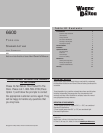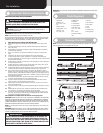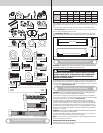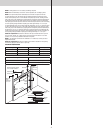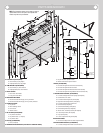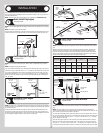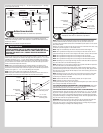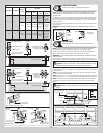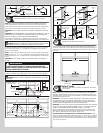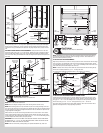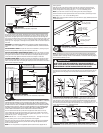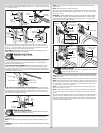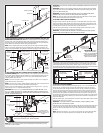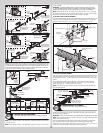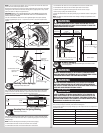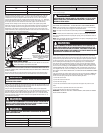
Pull down rope
(if included)
Inside lift handles
Cable drums RH/LH
Torsion
springs RH/LH
Center bracket (as required)
Center bracket
bushing (as required)
Lift handles
Pull handles
Stud plate
(as required)
(2) 3/8”- 16 Hex nuts(2) 5/16”-18 Hex nuts
End bearing bracket RH/LH (as required)
Counterbalance lift cables
Keys
(as required)
Center coupler
assembly (as required)
1/4”- 20 Flanged
hex nuts (as required)
5/16”- 18 Flanged
hex nuts (as required)
1/4”-20 x 9/16”
Track bolts (as required)
1/4”-20 x 7/8” Self
drilling screws (as required)
5/16”-18 x 1/2”
Carriage bolts (as required)
1/4”-14 x 5/8”
Tamper resistant Self
drilling screws (as required)
(2) 3/8”-16 x 3/4”
Truss head bolts
1/4”-20 x 11/16” Self
drilling screws (as required)
(2) Roller spacers
(as required)
3/8” Washer (as required)
1/4”-20 x 2-1/2” Carriage bolts (as required)
5/16” x 1 5/8” Hex head lag screws
(as required)
Backer plates (as required)
5/16”-18 x 3-1/2” Hex bolts
3/8”-16 x 1-1/2” Hex bolts
Door Section Identification
# Of Sections Door Height Bottom
Lock (sec-
ond)
Int I (third)
Int II
(fourth)
Top
4
7’ 0” 20.8” 20.8” 20.8” N/A 20.8”
7’ 6” 24” 20.8” 20.8” N/A 24”
8’ 0” 24” 24” 24” N/A 24”
5 9’ 0” 20.8” 20.8” 20.8” 20.8” 24”
When installing your door you must use sections of the appropriate height in the right stack-
ing order. What sections heights you need to use in what order depends on the height of your
door.
Unless your door is six sections in height, you will not receive an Intermediate III section.
The BOTTOM SECTION can be identified by the factory attached bottom astragal and by the
bottom bracket warning labels on each end stile.
The INTERMEDIATE I SECTION may have a warning label attached to either right or left
hand end stile of the section. This section is always the 3rd section from the bottom of the
door.
Intermediate I section
Bottom corner bracket warning labels
Bottom section
Bottom weather seal
Section
height
Warning labels
Section side view
Removing an Existing Door
IMPORTANT: COUNTERBALANCE SPRING TENSION MUST ALWAYS BE RELEASED BEFORE
ANY ATTEMPT IS MADE TO START REMOVING AN EXISTING DOOR.
WARNINGWARNING
A POWERFUL SPRING RELEASING ITS ENERGY SUDDENLY CAN CAUSE
SEVERE OR FATAL INJURY. TO AVOID INJURY, HAVE A TRAINED DOOR
SYSTEMS TECHNICIAN, USING PROPER TOOLS AND INSTRUCTIONS,
RELEASE THE SPRING TENSION.
For detailed information see supplemental instructions “Removing an Existing Door/ Prepar-
ing the Opening”. These instructions are not supplied with the door, but are available at no
charge from Wayne-Dalton, A Division Of Overhead Door Corporation, P.O. Box 67, Mt. Hope,
OH., 44660, or at www.Wayne-Dalton.com.
Preparing the Opening
IMPORTANT: IF YOU JUST REMOVED YOUR EXISTING DOOR OR YOU ARE INSTALLING A
NEW DOOR, COMPLETE ALL STEPS IN PREPARING THE OPENING.
To ensure secure mounting of track brackets, side and center brackets, or steel angles to
new or retro-fit construction, it is recommended to follow the procedures outlined in DASMA
technical data sheets #156, #161 and #164 at www.dasma.com.
The inside perimeter of your garage door opening should be framed with wood jamb
and header material. The jambs and header must be securely fastened to sound framing
members. It is recommended that 2” x 6” lumber be used. The jambs must be plumb and
the header level. The jambs should extend a minimum of 12” (305 mm) above the top of
the opening for Torsion counterbalance systems. For low headroom applications, the jambs
should extend to the ceiling height. Minimum side clearance required, from the opening to
the wall, is 3-1/2” (89 mm).
IMPORTANT: CLOSELY INSPECT JAMBS, HEADER AND MOUNTING SURFACE. ANY WOOD
FOUND NOT TO BE SOUND, MUST BE REPLACED.
For Torsion counterbalance systems, a suitable mounting surface (2” x 6”) must be firmly
attached to the wall, above the header at the center of the opening.
NOTE: Drill a 3/16” pilot hole in the mounting surface to avoid splitting the lumber. Do not
attach the mounting surface with nails.
WEATHERSTRIPS (MAY NOT BE INCLUDED):
Depending on the size of your door, you may have to cut or trim the weatherstrips (if neces-
sary) to properly fit into the header and jambs.
3



